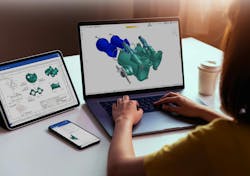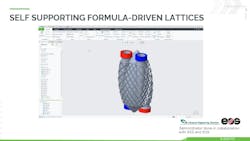Dive into Software Solutions that Support Additive Manufacturing
In the quickly evolving landscape of additive manufacturing (AM), the role of software is what drives improvements and efficiency. As companies look to optimize their processes and better their design capabilities, understanding the details of software solutions is necessary.
Machine Design reached out to two subject matter experts at PTC to help unravel the complexities and solutions that are paving the way for additive manufacturing excellence.
First, we’ll take a look at the company’s Creo software. In an interview with CAD Product Management Director Jose Coronado, we learn about the specific tools, integration with simulation and analysis, and the transition processes that this software offers. The spotlight falls on the built-in material libraries, design complexity challenges and geometric freedom that the platform provides.
Beyond specific software capabilities, a conversation with Dave Katzman, head of PTC’s Velocity Group, expands to encompass the broader landscape of computer aided design (CAD), computer aided manufacturing (CAM), product data management (PDM) and product lifecycle management (PLM) solutions that shape the future of design. We gain insights into the shift toward cloud-native technologies, the integration of sustainability practices in design processes and the evolving roles of artificial intelligence (AI) and machine learning (ML) in reshaping design and manufacturing landscapes.
Below are abridged versions of both interviews. Questions and answers have been edited for clarity.
5 Essential Questions about CAD/CAM Software for AM
From what tools or modules the software offers to support generative design to integration and simulation to the challenges of design complexity and freedom in AM, Coronado offers answers that relate to PTC’s Creo product.
Machine Design: What specific tools or modules does Creo offer to support generative design?
Jose Coronado: Creo’s journey into additive manufacturing began around 7-8 years ago, with a focus on integrating features like direct printer connections, lattice modeling and generative design seamlessly into the CAD system. These components within Creo work cohesively to enhance the AM workflow.
MD: How does Creo integrate with simulation and analysis tools to optimize designs?
JC: It provides users with a suite of simulation tools, including real-time simulation and extensive capabilities such as Creo Simulate based on Ansys solvers. This allows for in-depth analysis of designs prepared for AM, ensuring optimum performance and printability.
MD: Can Creo facilitate the seamless transition from CAD modeling to CAM tool path generation for AM equipment?
JC: It streamlines the transition process by enabling users to create, optimize and prepare 3D models for printing within the software itself. The user-friendly interface guides users through tasks such as adding support structures and generating printer-specific file formats, adding to the efficiency of the AM workflow.
MD: What about built-in material libraries and customization options?
JC: Creo empowers users to define and utilize material libraries with ease, supporting simulations tailored to specific materials required for AM. By leveraging material data provided by printer manufacturers and integrating it seamlessly into the software, Creo ensures accurate and efficient simulation outcomes.
MD: How does Creo address the challenges of design complexity and geometric freedom in AM?
JC: Its full associativity and parametric capabilities set it apart in addressing design challenges. By maintaining a synchronized digital thread throughout the design process, Creo allows for quick and effortless adjustments to designs, supporting the evolving nature of AM without the need for extensive rework.
SaaS: The Concept of a Single Source of Truth
It is important to understand the intricacies of CAD, CAM, PDM and PLM—the technologies that form the backbone of modern design processes and enable engineers to innovate, collaborate and bring products to market with efficiency and precision. To help navigate this landscape of advancements and challenges, Machine Design’s interview with Katzman helps shed some light on the subject.
MD: What current trends are you seeing in the CAD, CAM, PDM and PLM market, and how are they shaping the industry?
David Katzman: The industry is witnessing a shift toward cloud-native and cloud-based technologies, which allow for collaboration within organizations of all sizes. From large enterprises to small companies, there is a growing adoption of technologies like PLM for global supply chains.
MD: Why is cloud-native CAD and PDM becoming increasingly popular, and what benefits are offered over traditional systems?
DK: Cloud-native solutions offer a single source of truth, facilitating real-time collaboration on designs. This approach enables multiple stakeholders to work on the same design simultaneously, fostering efficiency and improved collaboration.
MD: How are companies expected to incorporate sustainability and eco-friendly practices into their design processes in the future?
DK: Sustainability is transitioning from a post-design consideration to an integral part of the design process. Engineers are now focusing on designing products with sustainability in mind, including material selection, production processes and overall environmental impact.
MD: How do you see the role of AI and ML evolving in CAD, CAM, PDM and PLM solutions and their impact on the design process?
DK: AI and ML are poised to revolutionize the design and manufacturing processes by offering features like generative design and design assistance. These technologies can enhance product innovation and streamline workflows, particularly when integrated with cloud-native solutions.
MD: What challenges do companies face when transitioning to collaborative design workflows, and how can they be effectively addressed?
DK: The main challenge lies in managing the cultural shift within engineering teams to embrace new technologies and collaborative workflows. Success lies in supporting employees through the change process and highlighting the benefits of enhanced collaboration and innovation.
MD: What factors should companies consider when selecting CAD, CAM, PDM and PLM solutions that align with their design and collaboration needs?
DK: Companies should prioritize improving their business processes and embracing change to enhance product design speed and quality. Selecting tools that foster collaboration, offer a single source of truth and enable data-driven decision making is key.
MD: How can companies leverage data analytics from these systems to optimize design processes, enhance product quality and improve time to market?
DK: Data analytics from these systems provide insights for proactive decision making, improving project timelines, resource allocation and overall design quality. It enables organizations to utilize real-time data to drive efficiency and innovation.
MD: What measures are taken to safeguard intellectual property when utilizing public datasets within these solutions?
DK: Public data sets are used for training AI models while maintaining confidentiality of personal information. Intellectual property of companies is protected, ensuring that data analysis focuses on metrics like activity duration and resource allocation without compromising proprietary information.
FULL INTERVIEW: SaaS: The Concept of a Single Source of Truth
About the Author
Sharon Spielman
Technical Editor, Machine Design
As Machine Design’s technical editor, Sharon Spielman produces content for the brand’s focus audience—design and multidisciplinary engineers. Her beat includes 3D printing/CAD; mechanical and motion systems, with an emphasis on pneumatics and linear motion; automation; robotics; and CNC machining.
Spielman has more than three decades of experience as a writer and editor for a range of B2B brands, including those that cover machine design; electrical design and manufacturing; interconnection technology; food and beverage manufacturing; process heating and cooling; finishing; and package converting.
Email: [email protected]
LinkedIn: @sharonspielman
Facebook: Machine Design
YouTube: @MachineDesign-EBM






